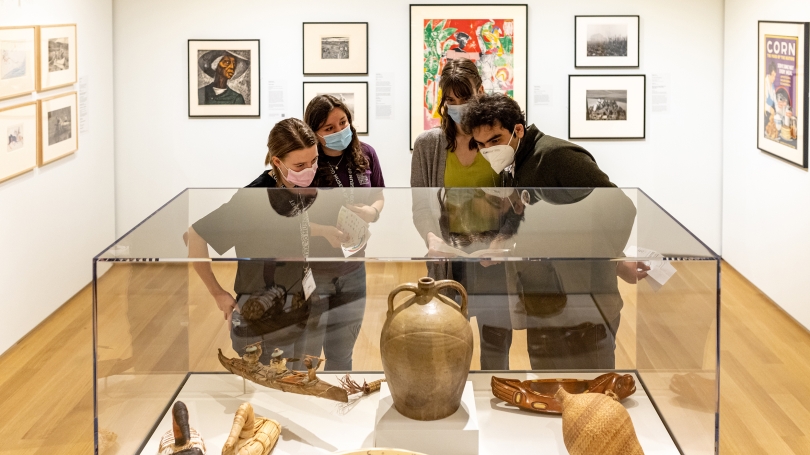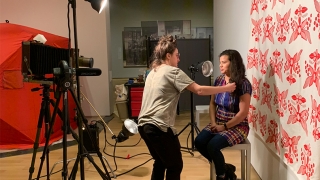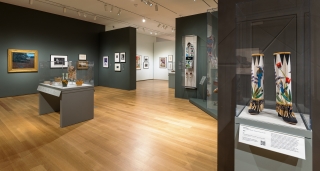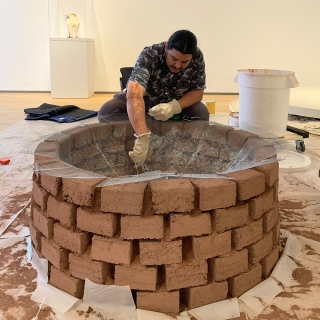
LEFT Dartmouth students explore the exhibition This Land: American Engagement with the Natural World on view January 6, 2021–July 23, 2022. Photo by Lars Blackmore.


ABOVE Native American artist Kali Spitzer works with a sitter during her residency with Will Wilson in conjunction with the exhibition "CIPX Dartmouth with Kali Spitzer and Will Wilson" in 2020.
This strategic plan activates the possibility inherent in the museum's new facilities and dynamic organization. It refocuses longstanding institutional goals for experiential learning by expanding the artists and audiences with, about, and from whom we learn—through art and material culture, diverse programming, and shared curiosity.
The Tod Williams / Billie Tsien–designed building expansion opened in 2019 with a staff eager to re-embrace Dartmouth students and our extended community. COVID-19, however, sidelined those ambitions. This plan outlines the Hood Museum's optimistic reengagement with all its communities and a still-emerging, pandemic-informed cultural, social, and civic ecosystem.
The Hood Museum will proactively invite new voices into its spaces and practices. Through an array of expanded and new initiatives, the museum will place art and people at the center of its work, advancing mutual learning, care, and connections. Through transformative encounters with works of artistic and cultural significance, it will continue to advance critical thinking and enrich people's lives.
Such initiatives will feature post-baccalaureate fellowships; visiting curator opportunities; increased funding for underrepresented areas of the collection; and robust digital access to the collection. Buoyed by its responsible financial stewardship through the global economic crisis and with the College's steadfast enthusiasm, the Hood Museum is poised to blaze a meaningful and inclusive path for Dartmouth students, faculty, and staff; regional residents and teachers; and artists and all art-interested audiences.

LEFT Dartmouth students explore the exhibition "This Land: American Engagement with the Natural World" at a Hood After 5 event in winter 2022. Photo by Lars Blackmore.
The Hood Museum of Art, Dartmouth, centers art and people in teaching and learning through inclusive and robust academic, cultural, and civic engagements with art and its histories.
The Hood Museum will advance learning, care, and connections through the reach and relevance of visual art and material culture. As a nexus for the exchange of ideas, the museum will:
Institutional behaviors that the Hood staff will privilege in their decision making and through their work with peers, partners, audiences, and others.
Goal 1: Deepen the Hood Museum's educational impact across Dartmouth and the region
Establish the Hood as a central place for Dartmouth students, faculty, staff, and regional communities to generate new perspectives, imaginings, knowledge, and joy. Through academic, co-curricular, social, and civic interactions, museum users will discover and co-create opportunities for meaningful and lasting benefits. They will gain a sense of ownership in the Hood through engaged scholarship and education, professional development, and more.
Representative actions

LEFT Hood after 5 student event, October 2021. Photo by Lars Blackmore.

ABOVE "This Land: American Engagement with the Natural World" installed in Rush and Sack Galleries. Photo by Rob Strong.
Goal 2: Reimagine the collection's influence and potential
Activate the permanent collections through critical scholarship, publications, and access. Develop ethical and sustainable practices for owning, cataloging, and utilizing the Hood's holdings. Bring new and multiple perspectives into the conversations.
Representative actions

ABOVE Dartmouth students in the Hood Museum of Art's Bernstein Center for Object Study.
Goal 3: Enable greater access to the Hood's resources
Increase and enhance access to the Hood Museum's resources—spaces, staff, collections, programs, networks, social media, and so forth—to generate insights into our cultures and our times. Invite perspectives from outside the museum to influence decisions around programmatic conception, design, and interpretation, creating a more shared platform for the creation of content and understanding.
Representative actions

ABOVE Native American Artist Ruben Olguin installing his site-specific installation for "Form and Relation: Contemporary Native Ceramics." Photo by Alison Palizzolo.
Goal 4: Spark imaginations and activate spaces of possibility
Promote creativity and risk taking among the Hood's staff, users, partners, and publics. Embrace uncertainty and provocation as essential stimulants to discovery, understanding, and intellectual and social exchange.
Representative actions
Goal 5: Champion sustainable museum practice
Infuse the museum's operations with an appreciation and concern for its impact on the people who interact with it (e.g., staff, artists, students, community members, faculty, and so forth), as well as its ecological impact. Create an environment in which the museum continues to improve, and one that promotes well-being.
Representative actions
The Hood Museum staff wishes to thank Tom Shapiro of Cultural Strategy Partners for his consultation throughout this strategic planning process and his contribution to both the direction and the document that resulted from it.

LEFT The fellows' first day on site, (left to right) Nicki Gaumont, Beatriz Yanes Martinez, and Jayde Xu, October 2021. Photo by Meredith Steinfels.